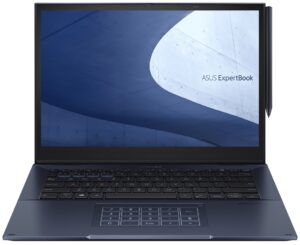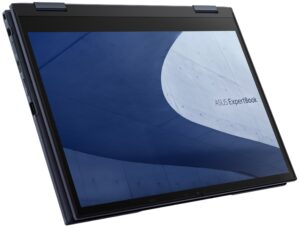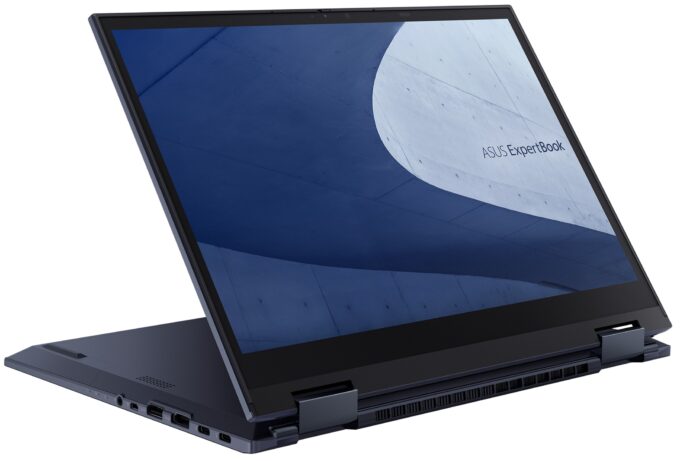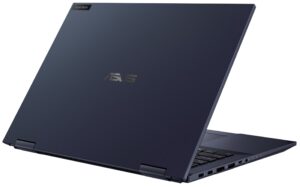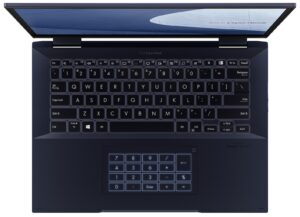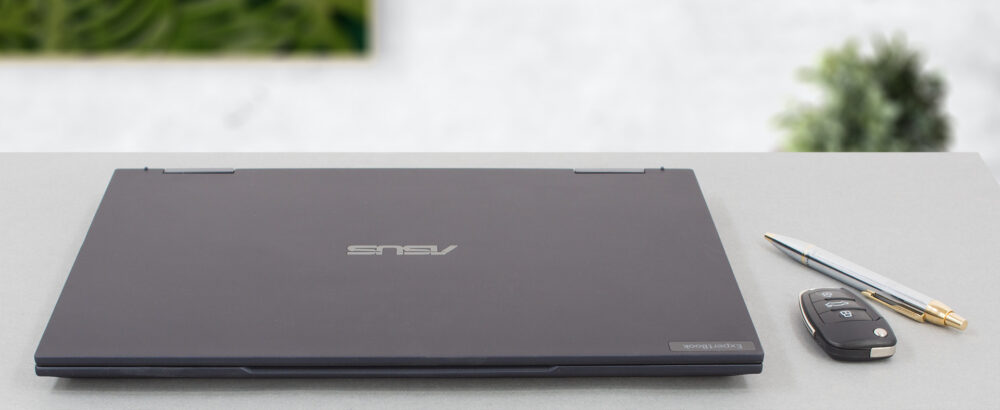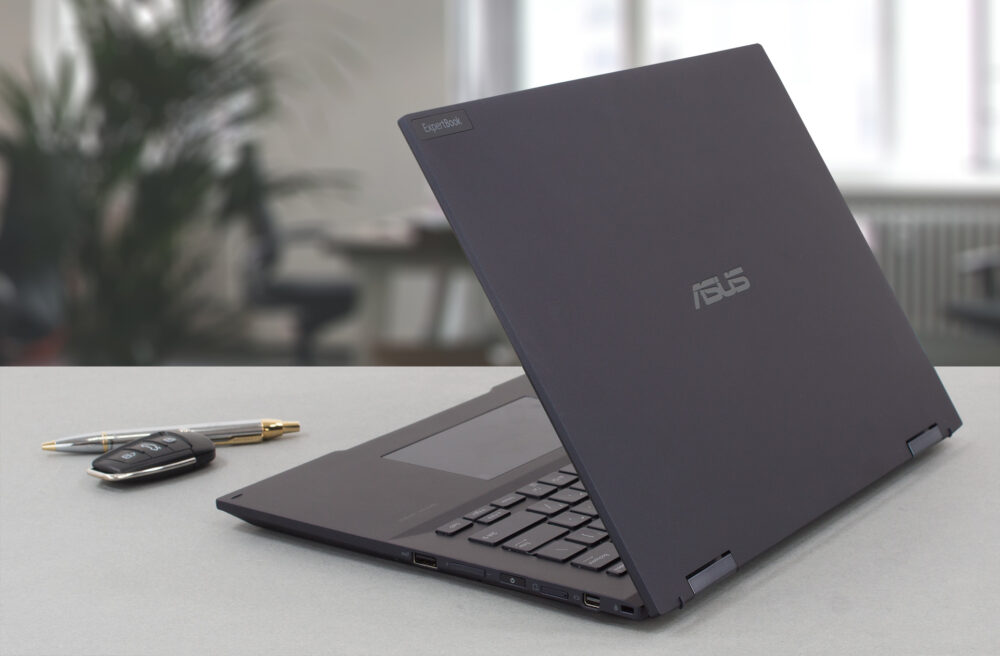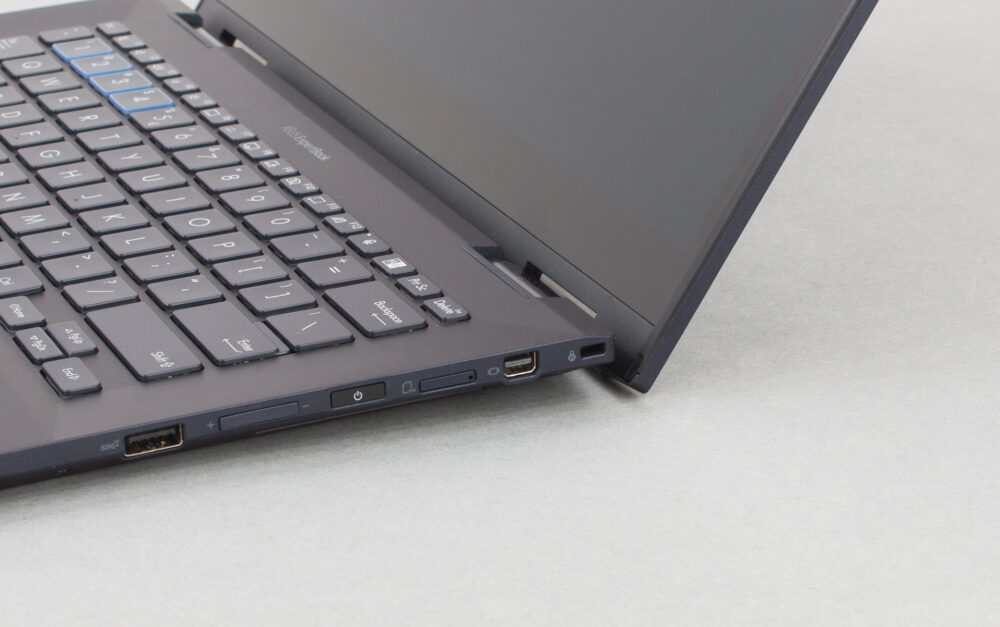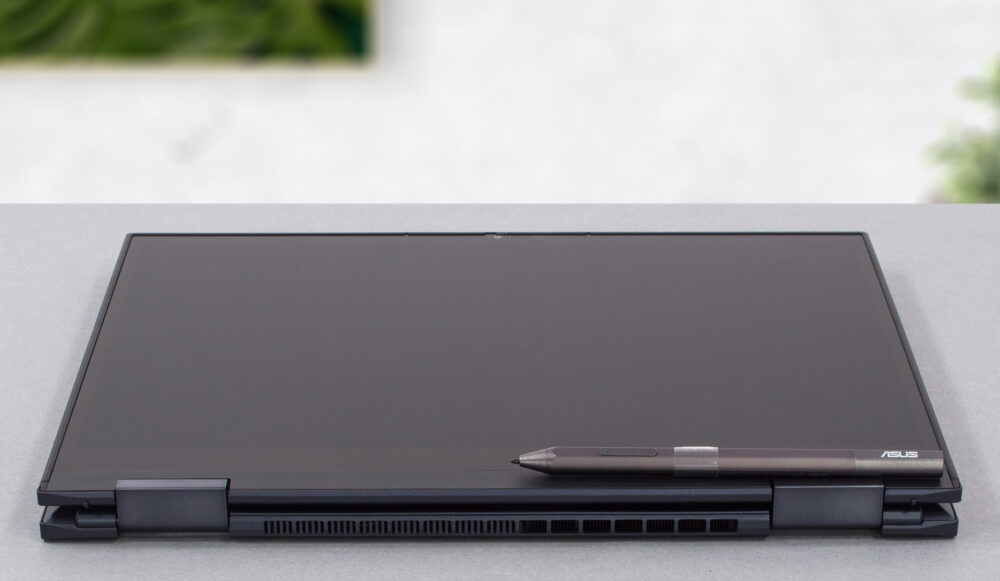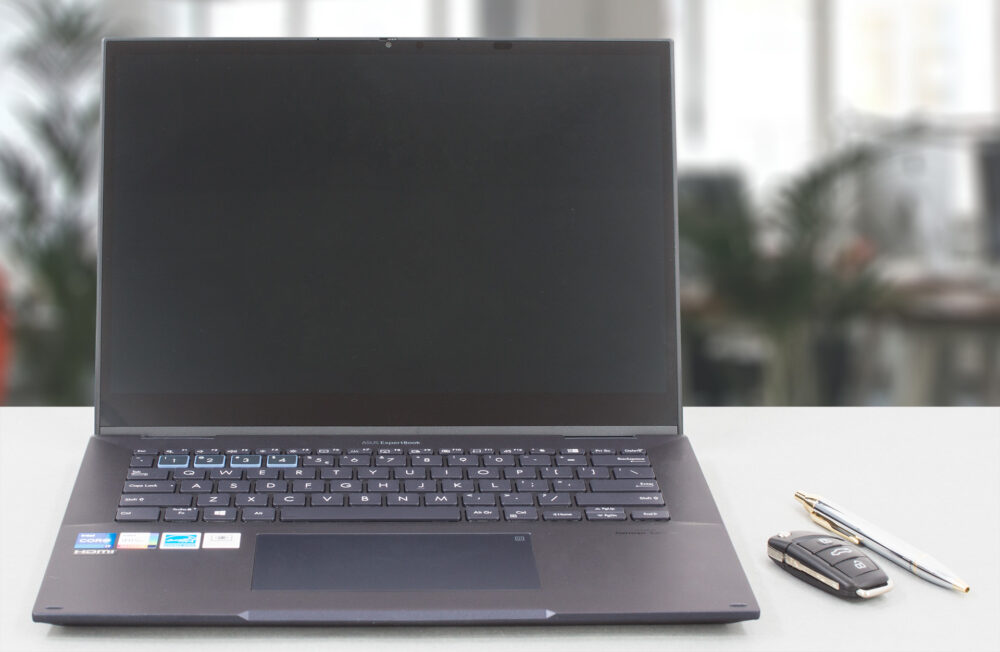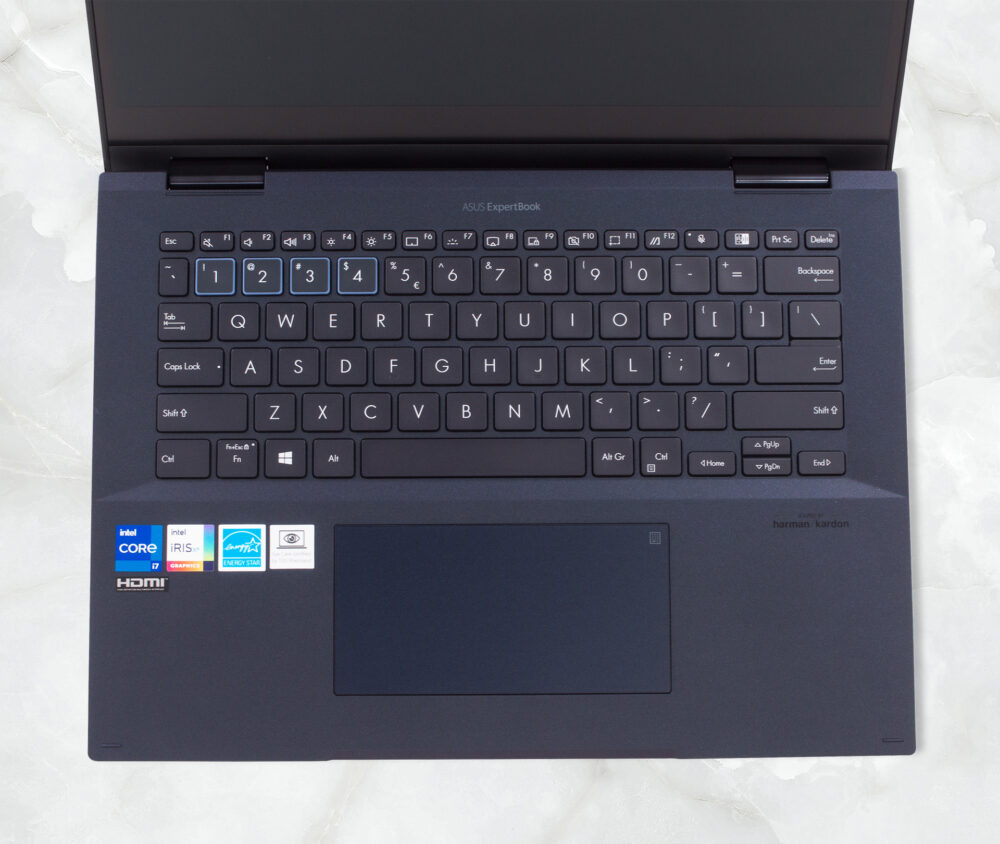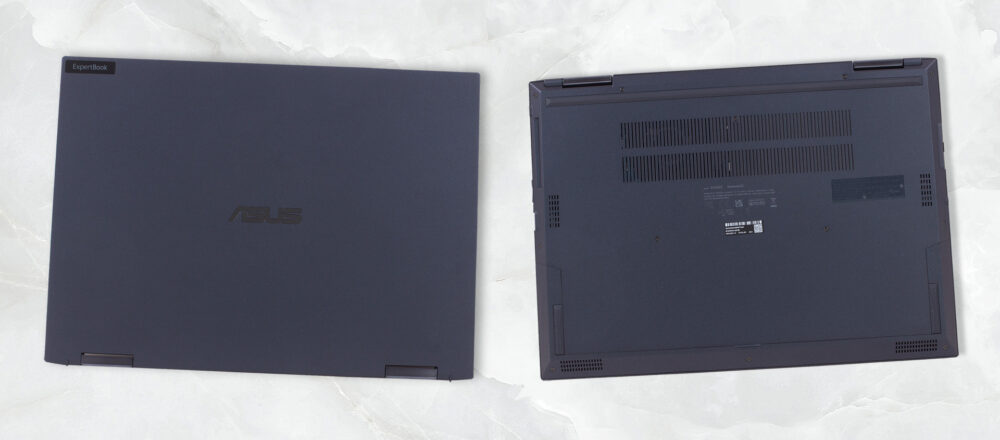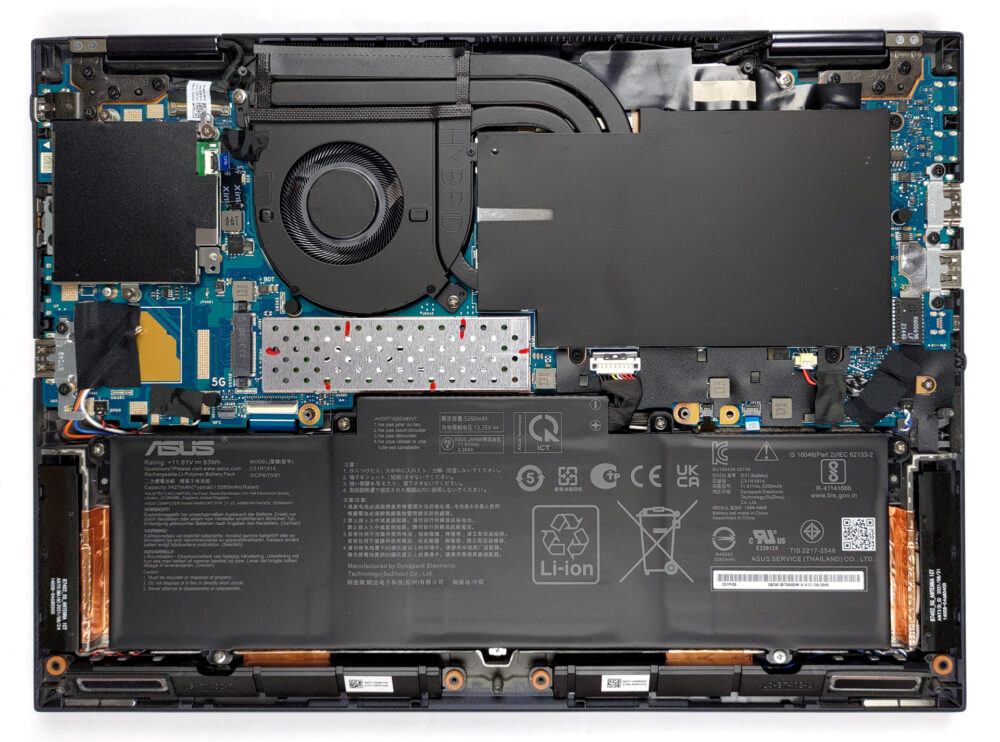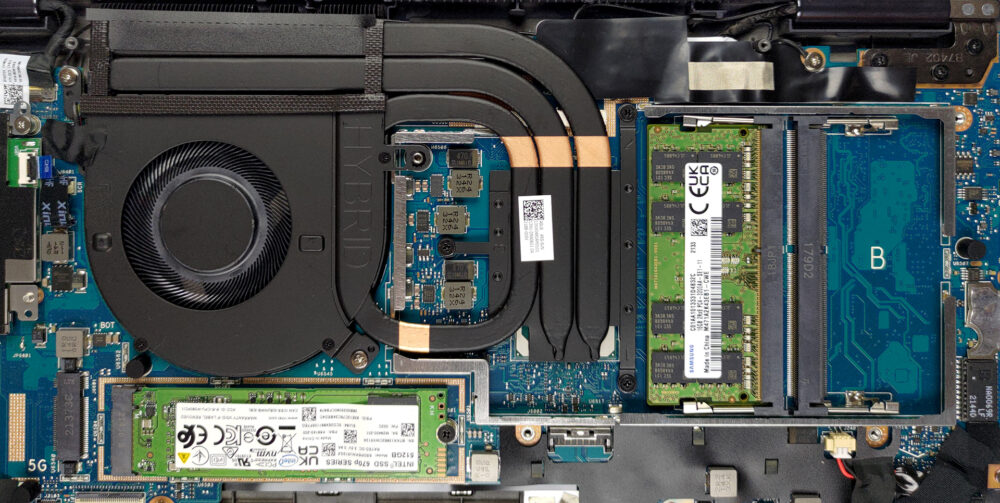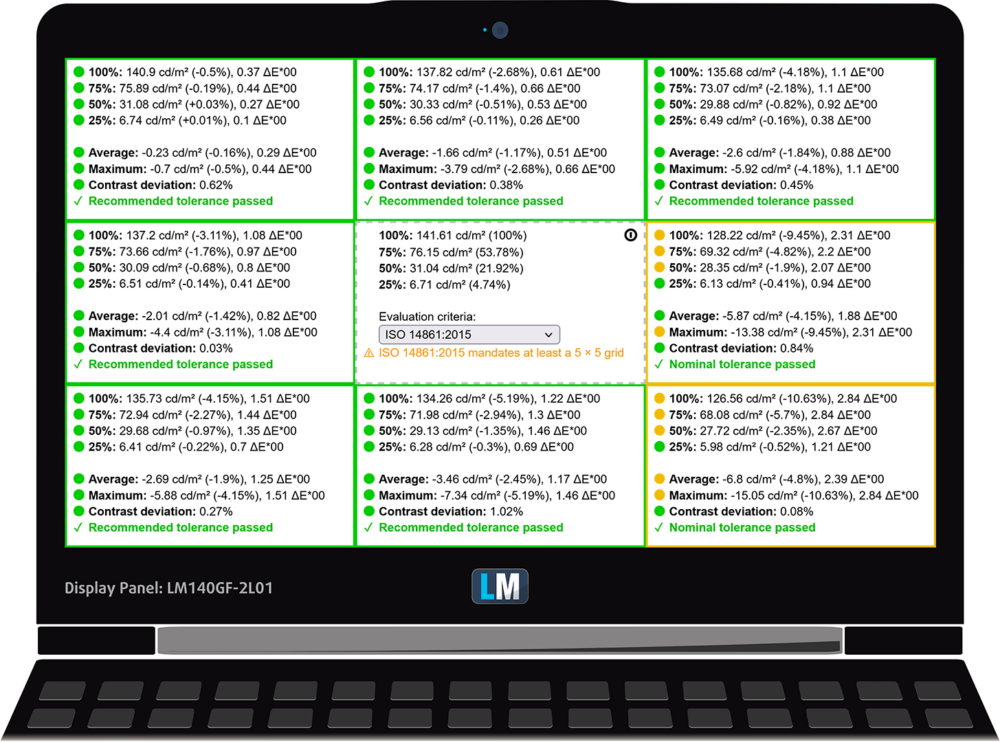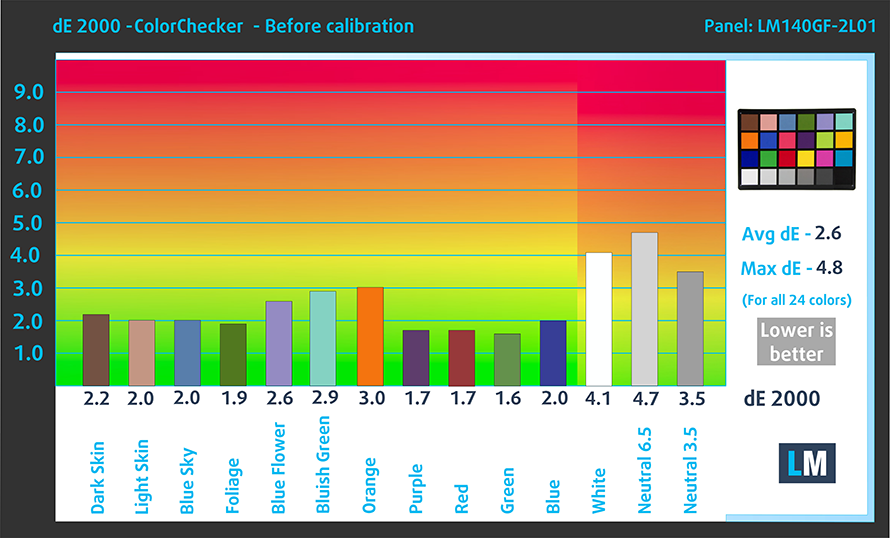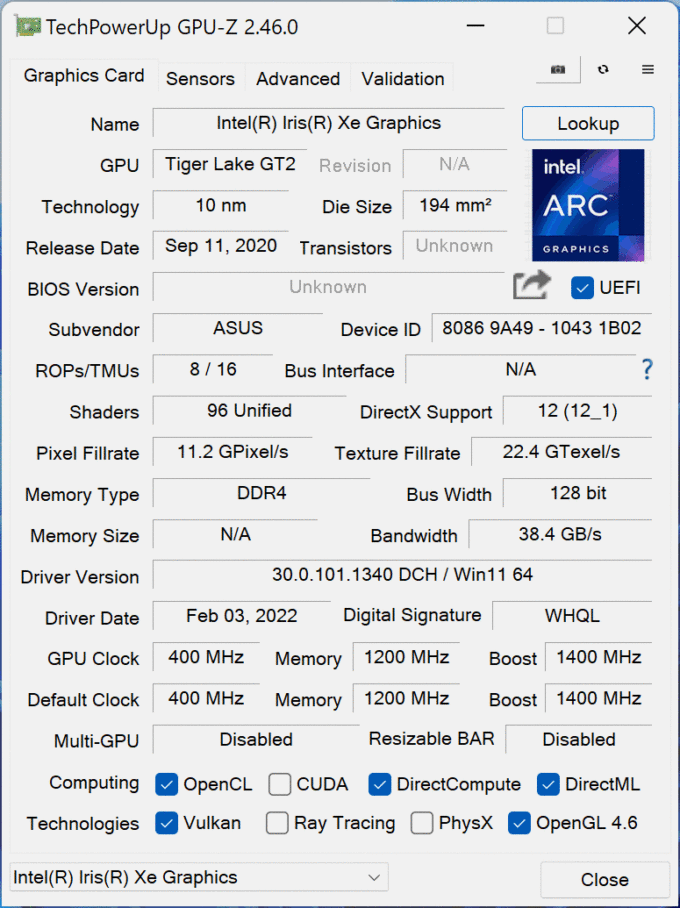ASUS ExpertBook B7 Flip (B7402F) review
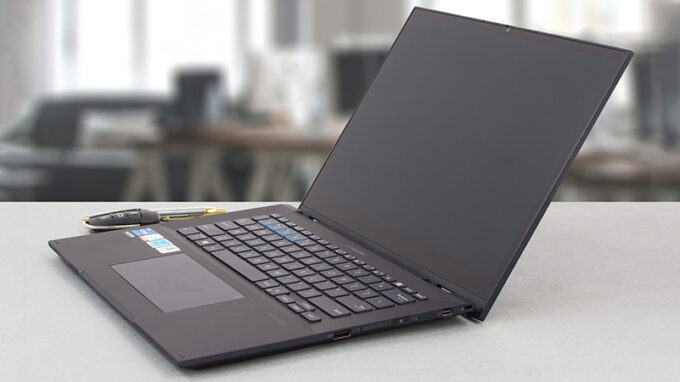 As with every niche in the mobile market, the business segment boasts a broad diversity. From laptops that are just there to help you work to such, that make your work as pleasant as it can get. Well, today, we have a machine that is slightly different in the way, that regards its connectivity. We are talking about fast, reliable, and stable connections – something that you can’t always rely on when you are in your closest coffee shop or the hotel at the shoreline.
As with every niche in the mobile market, the business segment boasts a broad diversity. From laptops that are just there to help you work to such, that make your work as pleasant as it can get. Well, today, we have a machine that is slightly different in the way, that regards its connectivity. We are talking about fast, reliable, and stable connections – something that you can’t always rely on when you are in your closest coffee shop or the hotel at the shoreline.
This is where 5G comes in. Of course, the feature is optional, but you have to keep in mind that in these early days of 5G, not many laptops come with it. Of course, this is not all the ExpertBook B7 Flip (B7402F) is about. After all, it is a convertible, and its display is also really important.
This is why ASUS gives you the option of a 2560×1600 IPS touchscreen panel with a 16:10 aspect ratio, high brightness, and supposed 100% sRGB coverage. Not only that, but the hardware that pushes it is quite decent – the latest and greatest Tiger Lake-U processors from Intel. Respectively, they are cooled down by an improved thermal solution. We’ll give you more details about that later on.
You can check the prices and configurations in our Specs System: https://laptopmedia.com/series/asus-expertbook-b7-flip-b7402f/
Contents
Specs Sheet
- HDD/SSD
- up to 2000GB SSD
- M.2 Slot
- 1x 2280 M.2 PCIe x4 Gen 3 slot
- RAM
- up to 64GB
- OS
- No OS, Windows 11 Pro, Windows 10 Pro, Windows 11 Home
- Battery
- 63Wh, 3-cell
- Body material
- Magnesium alloy
- Dimensions
- 320 x 234.2 x 18 - 18.9 mm (12.60" x 9.22" x 0.71")
- Weight
- 1.44 kg (3.2 lbs)
- Ports and connectivity
- 2x USB Type-A
- 3.2 Gen 2 (10 Gbps)
- 2x USB Type-C
- Thunderbolt 4, Power Delivery (PD), DisplayPort
- HDMI
- 2.0b
- Displayport mini
- Card reader
- Ethernet LAN
- Wi-Fi
- 802.11ax
- Bluetooth
- 5.2
- Audio jack
- 3.5mm Combo Jack
- SIM Card Slot
- Smart Card Reader
- Optional 5G Support
- Features
- Fingerprint reader
- Web camera
- HD IR with Windows Hello
- Backlit keyboard
- Microphone
- Array Microphone with Cortana Support
- Speakers
- 2x Speakers, Smart Amp, Harman Karbon
- Optical drive
- Security Lock slot
All ASUS ExpertBook B7 Flip (B7402F, 11th Gen Intel) configurations
What’s in the box?
This laptop’s packaging includes a 65W USB Type-C charger, some paperwork, an ASUS Pen, a micro HDMI to LAN port dongle, and a SIM card tray ejection tool.
Design and construction
The ExpertBook B7 Flip features a rather industrial rough finish, which is a huge enemy to fingerprints and smudges. Interestingly, the material beneath is magnesium-aluminum alloy. This, combined with more metal support on the inside, results in a very rigid base, which shows almost zero flex when twisted.
It’s good to know that the laptop has passed the MIL-STD-810H military standards for durability. Indeed, the lid is a bit more bendy, even though the display features a glass cover by Corning. In terms of dimensions, the device is pretty respectable with a profile of 18-18.9mm, and a weight of 1.44 kg.
Unsurprisingly, the lid can’t be opened with one hand. However, the side bezels look pretty thin, while the top one houses an HD Web camera, a privacy shutter, and an IR face recognition sensor. Furthermore, the lid acts as a lever and lifts the backside of the base in order to provide better airflow to the fan.
Another interesting aspect of the display is that it has an anti-reflective layer on top. This doesn’t prevent the touchscreen from working effortlessly with the included ASUS Pen. We also have to say, that the display sits completely flat when you use it in “tablet” mode, with no bouncing and jiggering.
Moving to the keyboard, we see a pretty standard solution with a backlight and spill resistance. Its key travel is decent, while the feedback is clicky, which results in a very comfortable typing experience. By the way, there is a dedicated shortcut to the AI Noise cancellation function.
Thankfully, the touchpad features a glass surface, which makes the gliding extremely smooth. Also, its tracking is very accurate. What makes it even better is the NumberPad capability.
Turn the laptop upside down, and you will find two speaker cutouts, as well as the ventilation grill. As far as the hot air exhaust goes, there is a vent in between the lid and the base.
Ports
On the left side, you get two Thunderbolt 4 connectors, an HDMI 2.0b connector, a micro HDMI connector, and an audio jack. Then, on the right, there is a Kensington lock slot, a Mini DisplayPort, a SIM card tray, followed by the Power button, the volume rocker, and a USB Type-A 3.2 (Gen. 2) port.
Disassembly, upgrade options and maintenance
To access this laptop’s internals, you need to undo a total of 12 Phillips-head screws. Then, pry the bottom panel with a plastic tool, starting from the back.
Inside, we see a 63Wh battery pack. It lasts for 12 hours and 30 minutes of Web browsing, or 9 hours of video playback. To remove it, unplug the battery connector, and undo all 6 Phillips-head screws keeping it in place.
Here, the memory is hidden beneath a protective metal shroud. You can take it out by removing three Phillips-head screws. Then, gently lift it away. This reveals two SODIMM slots, which fit up to 64GB of DDR4 RAM in total. The storage is also protected by a metal shroud but this one is way easier to remove. It hides a single M.2 PCIe x4 slot.
Now, the cooling is really interesting. There are two heat pipes, which are connected to a heat sink of regular size. A third one finds itself attached to the side of the fan housing, which is thermally conductive and helps dissipate even more heat.
Display quality
ASUS ExpertBook B7 Flip (B7402F) uses a WUXGA IPS touchscreen panel, model number Panda LM140GF-2L01 (NCP0061). Its diagonal is 14″ (35.6 cm), and the resolution – 2560 x 1600. Additionally, the screen ratio is 16:10, the pixel density – 216 ppi, their pitch – 0.12 x 0.12 mm. The screen can be considered Retina when viewed from at least 41 cm (from this distance, the average human eye can’t see the individual pixels).
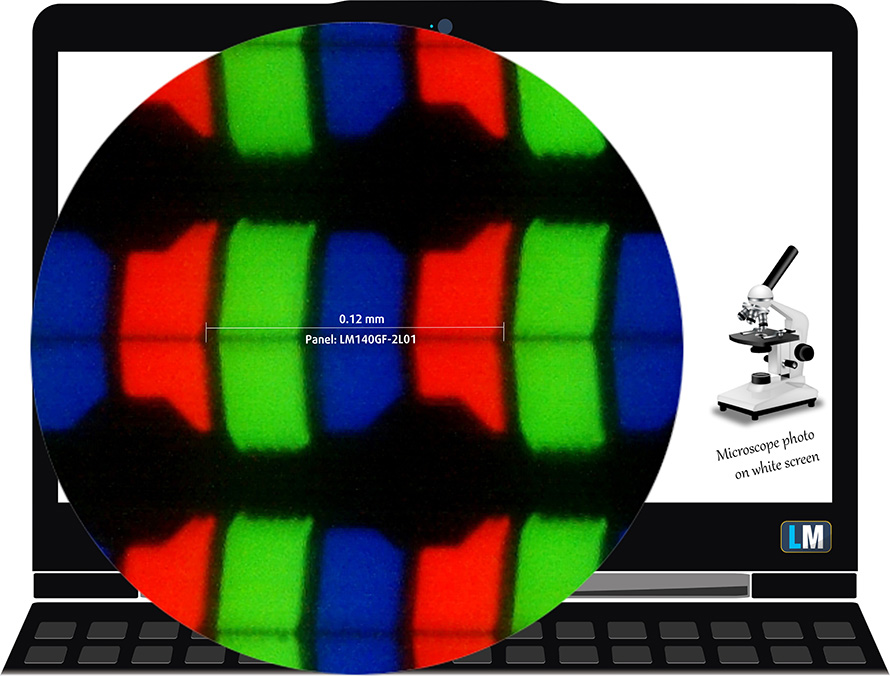
Viewing angles are comfortable. We have provided images at 45 degrees to evaluate quality.
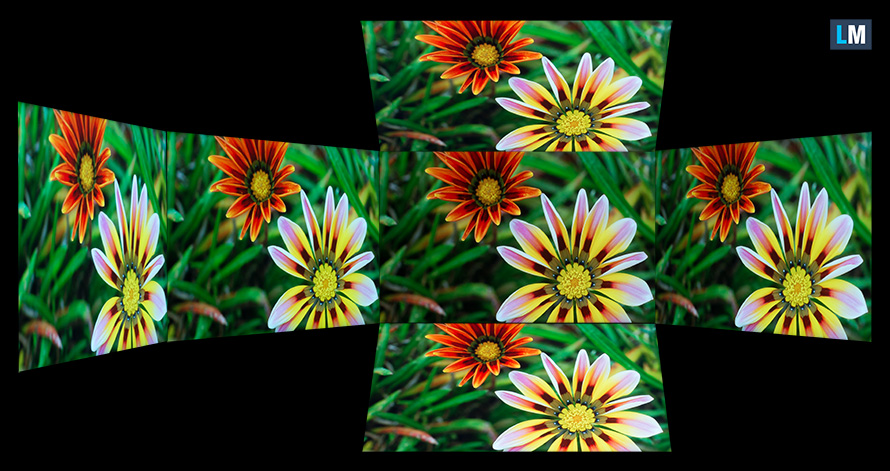
Also, a video with locked focus and exposure.
The maximum measured brightness is 484 nits (cd/m2) in the middle of the screen and 461 nits (cd/m2) average across the surface with a maximum deviation of 10%. The Correlated Color Temperature on a white screen and at maximum brightness is 7220K (average) – colder than the 6500K optimum for sRGB.
In the illustration below you can see how the display performs from a uniformity perspective. The illustration below shows how matters are for operational brightness levels (approximately 140 nits) – in this particular case at 37% Brightness (White level = 142 cd/m2, Black level = 0.10 cd/m2).
Values of dE2000 over 4.0 should not occur, and this parameter is one of the first you should check if you intend to use the laptop for color-sensitive work (a maximum tolerance of 2.0 ). The contrast ratio is good – 1380:1.
To make sure we are on the same page, we would like to give you a little introduction to the sRGB color gamut and the Adobe RGB. To start, there’s the CIE 1976 Uniform Chromaticity Diagram that represents the visible specter of colors by the human eye, giving you a better perception of the color gamut coverage and the color accuracy.
Inside the black triangle, you will see the standard color gamut (sRGB) that is being used by millions of people on HDTV and on the web. As for Adobe RGB, this is used in professional cameras, monitors, etc for printing. Basically, colors inside the black triangle are used by everyone and this is the essential part of the color quality and color accuracy of a mainstream notebook.
Still, we’ve included other color spaces like the famous DCI-P3 standard used by movie studios, as well as the digital UHD Rec.2020 standard. Rec.2020, however, is still a thing of the future and it’s difficult for today’s displays to cover that well. We’ve also included the so-called Michael Pointer gamut, or Pointer’s gamut, which represents the colors that naturally occur around us every day.
The yellow dotted line shows ASUS ExpertBook B7 Flip (B7402F)’s color gamut coverage.
Its display covers 98% of the sRGB/ITU-R BT.709 (web/HDTV standard) in CIE1976.
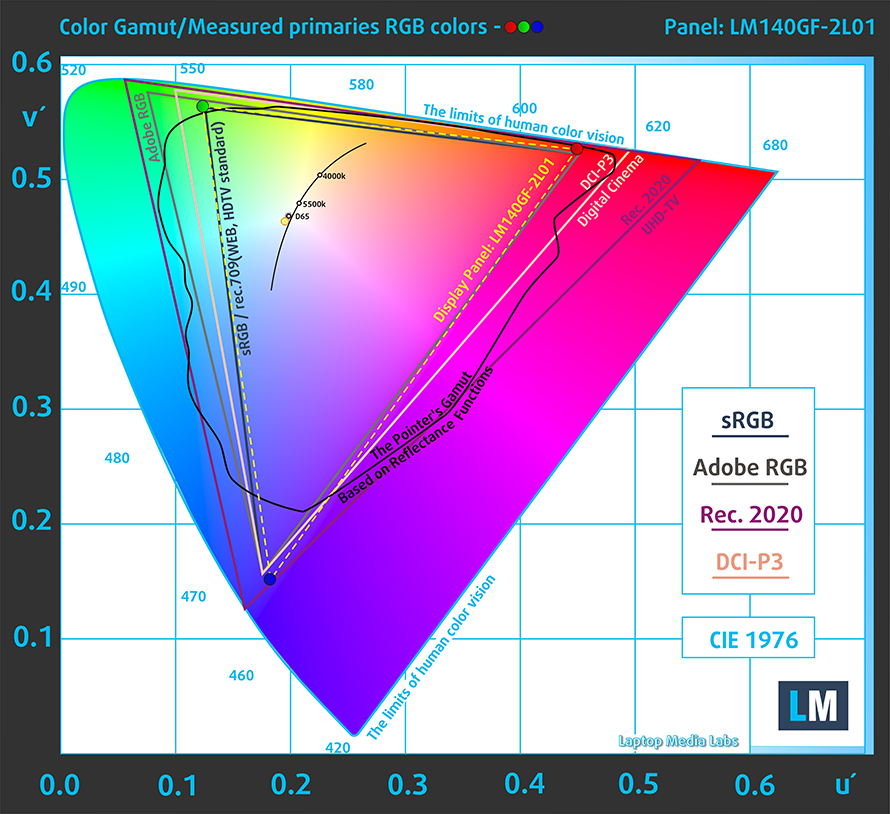
Our “Design and Gaming” profile delivers optimal color temperature (6500K) at 140 cd/m2 luminance and sRGB gamma mode.
We tested the accuracy of the display with 24 commonly used colors like light and dark human skin, blue sky, green grass, orange, etc. You can check out the results at factory condition and also, with the “Design and Gaming” profile.
Below you can compare the scores of ASUS ExpertBook B7 Flip (B7402F) with the default settings (left), and with the “Gaming and Web design” profile (right).
The next figure shows how well the display is able to reproduce really dark parts of an image, which is essential when watching movies or playing games in low ambient light.
The left side of the image represents the display with stock settings, while the right one is with the “Gaming and Web Design” profile activated. On the horizontal axis, you will find the grayscale, and on the vertical axis – the luminance of the display. On the two graphs below you can easily check for yourself how your display handles the darkest nuances but keep in mind that this also depends on the settings of your current display, the calibration, the viewing angle, and the surrounding light conditions.

Response time (Gaming capabilities)
We test the reaction time of the pixels with the usual “black-to-white” and “white-to-black” method from 10% to 90% and vice versa.
We recorded Fall Time + Rise Time = 26 ms.
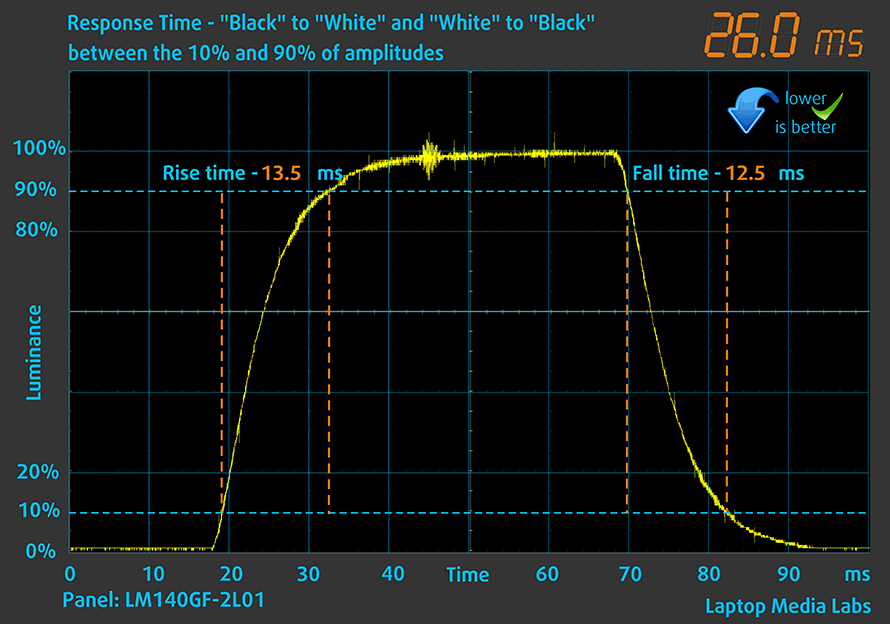
After that, we test the reaction time of the pixels with the usual “Gray-to-Gray” method from 50% White to 80% White and vice versa between 10% and 90% of the amplitude.
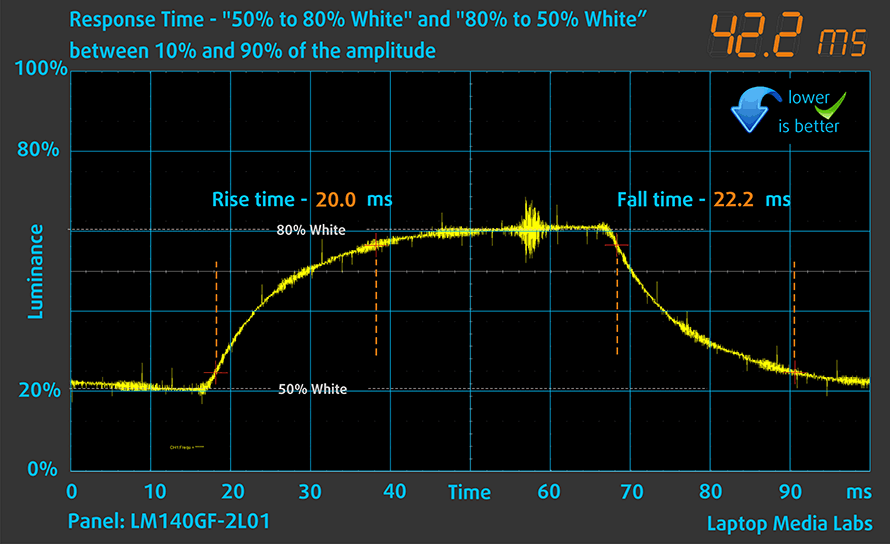
Health impact – PWM / Blue Light
PWM (Screen flickering)
Pulse-width modulation (PWM) is an easy way to control monitor brightness. When you lower the brightness, the light intensity of the backlight is not lowered, but instead turned off and on by the electronics with a frequency indistinguishable to the human eye. In these light impulses, the light/no-light time ratio varies, while brightness remains unchanged, which is harmful to your eyes. You can read more about that in our dedicated article on PWM.
ASUS ExpertBook B7 Flip (B7402F)’s backlight doesn’t use PWM for brightness adjustment. This makes it comfortable for long periods of use.

Blue light emissions
Installing our Health-Guard profile not only eliminates PWM but also reduces the harmful Blue Light emissions while keeping the colors of the screen perceptually accurate. If you’re not familiar with the Blue light, the TL;DR version is – emissions that negatively affect your eyes, skin, and your whole body. You can find more information about that in our dedicated article on Blue Light.
Buy our profiles
Since our profiles are tailored for each individual display model, this article and its respective profile package are meant for ASUS ExpertBook B7 Flip (B7402F) configurations with 14.0″ Panda LM140GF-2L01 (NCP0061) (WQXGA, 2560 x 1600) IPS.
*Should you have problems with downloading the purchased file, try using a different browser to open the link you’ll receive via e-mail. If the download target is a .php file instead of an archive, change the file extension to .zip or contact us at [email protected].
Read more about the profiles HERE.
In addition to receiving efficient and health-friendly profiles, by buying LaptopMedia's products you also support the development of our labs, where we test devices in order to produce the most objective reviews possible.

Office Work
Office Work should be used mostly by users who spend most of the time looking at pieces of text, tables or just surfing. This profile aims to deliver better distinctness and clarity by keeping a flat gamma curve (2.20), native color temperature and perceptually accurate colors.

Design and Gaming
This profile is aimed at designers who work with colors professionally, and for games and movies as well. Design and Gaming takes display panels to their limits, making them as accurate as possible in the sRGB IEC61966-2-1 standard for Web and HDTV, at white point D65.

Health-Guard
Health-Guard eliminates the harmful Pulse-Width Modulation (PWM) and reduces the negative Blue Light which affects our eyes and body. Since it’s custom tailored for every panel, it manages to keep the colors perceptually accurate. Health-Guard simulates paper so the pressure on the eyes is greatly reduced.
Get all 3 profiles with 33% discount
Sound
ASUS ExpertBook B7 Flip (B7402F)’s speakers produce a sound of very good quality. Its low, mid, and high tones are clear of deviations.
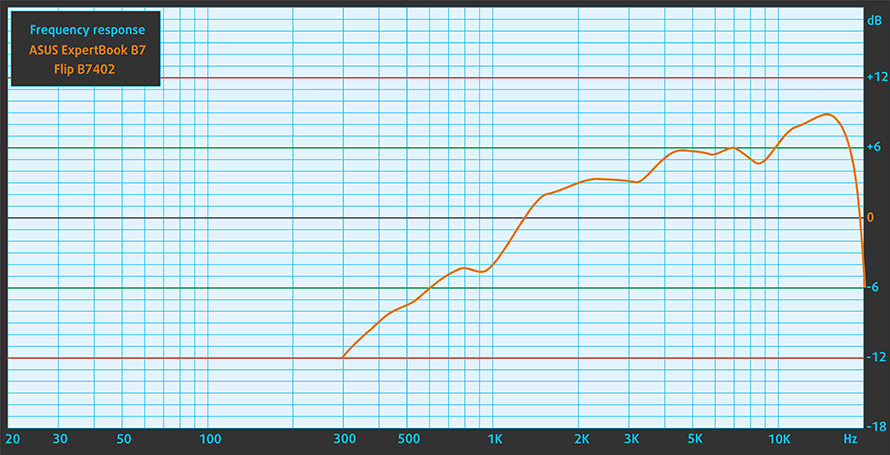
Drivers
All drivers and utilities for this notebook can be found here: https://www.asus.com/Laptops/For-Work/ExpertBook/ExpertBook-B7-Flip-B7402F-11th-Gen-Intel/HelpDesk_Download/
Battery
Now, we conduct the battery tests with the Windows Better performance setting turned on, screen brightness adjusted to 120 nits, and all other programs turned off except for the one we are testing the notebook with. This laptop’s 63Wh battery lasts for 12 hours and 43 minutes of Web browsing, or 9 hours and 10 minutes of video playback.
In order to simulate real-life conditions, we used our own script for automatic web browsing through over 70 websites.

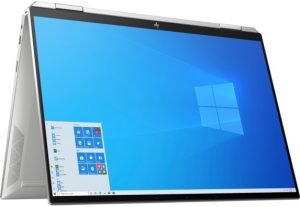
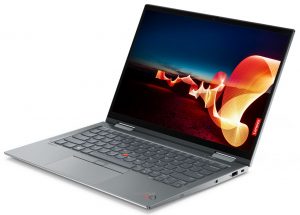
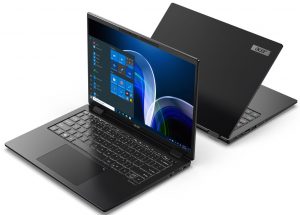
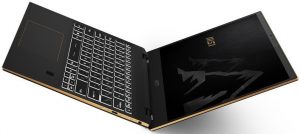
For every test like this, we use the same video in HD.





CPU options
Currently, this machine can be found with the Core i5-1155G7 and the Core i7-1195G7.
Results are from the Cinebench R23 CPU test (the higher the score, the better)
Results are from our Photoshop benchmark test (the lower the score, the better)
GPU options
Since there is no dedicated graphics option, you only get the integrated Iris Xe Graphics G7.
Results are from the 3DMark: Time Spy (Graphics) benchmark (higher the score, the better)
Results are from the 3DMark: Fire Strike (Graphics) benchmark (higher the score, the better)
Results are from the 3DMark: Wild Life benchmark (higher the score, the better)
Results are from the Unigine Superposition benchmark (higher the score, the better)
Gaming tests

| CS:GO | HD 1080p, Low (Check settings) | HD 1080p, Medium (Check settings) | HD 1080p, MAX (Check settings) |
|---|---|---|---|
| Average FPS | 93 fps | 73 fps | 33 fps |

| DOTA 2 | HD 1080p, Low (Check settings) | HD 1080p, Normal (Check settings) | HD 1080p, High (Check settings) |
|---|---|---|---|
| Average FPS | 95 fps | 60 fps | 36 fps |
Temperatures and comfort
Max CPU load
In this test we use 100% on the CPU cores, monitoring their frequencies and chip temperature. The first column shows a computer’s reaction to a short load (2-10 seconds), the second column simulates a serious task (between 15 and 30 seconds), and the third column is a good indicator of how good the laptop is for long loads such as video rendering.
Average core frequency (base frequency + X); CPU temp.
| Intel Core i7-1195G7 (15W TDP) | 0:02 – 0:10 sec | 0:15 – 0:30 sec | 10:00 – 15:00 min |
|---|---|---|---|
| ASUS ExpertBook B7 Flip (B7402F) | 3.66 GHz (B+26%) @ 91°C | 3.42 GHz (B+18%) @ 91°C | 2.80 GHz @ 82°C |
| HP Spectre x360 14 (14-ea1000) | 3.13 GHz (B+8%) @ 97°C | 2.88 GHz @ 97°C | 2.76 GHz @ 90°C |
| HP Envy x360 15 (15-es1000) | 3.49 GHz (B+20%) @ 95°C | 2.95 GHz (B+2%) @ 95°C | 2.80 GHz @ 91°C |
| Acer Aspire Vero (AV15-51) | 3.93 GHz (B+36%) @ 77°C | 3.58 GHz (B+23%) @ 77°C | 3.10 GHz (B+7%) @ 68°C |
When we compare the ExpertBook B7 Flip to the similarly-specced Spectre x360 14, we see a decent advantage for the ASUS. It works at higher clocks, while the temperature of the CPU is always lower.
Comfort during full load
In addition, the fan was not too loud during the stress test, which is great. And while the 40°C in the middle of the keyboard could have ideally been cooler, they are not too hot either.
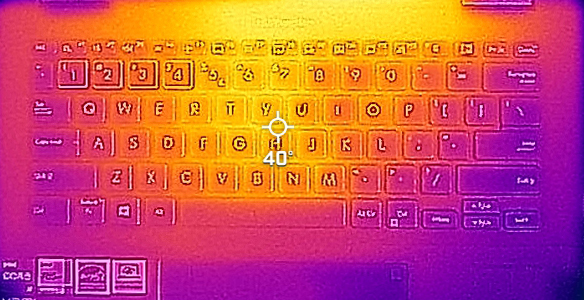
Verdict
 Although the ExpertBook brand was largely unknown a couple of years ago, it has now established itself as a very solid player in the business market. ASUS is definitely doing its best to undermine the competition, which relies on its old popularity. The ExpertBook B7 Flip (B7402F) is a brilliant example of this.
Although the ExpertBook brand was largely unknown a couple of years ago, it has now established itself as a very solid player in the business market. ASUS is definitely doing its best to undermine the competition, which relies on its old popularity. The ExpertBook B7 Flip (B7402F) is a brilliant example of this.
It is so packed with features, that we don’t even know where to start our summary. Now, since the official Web page is all about the 5G support, we would start there. Even though this is an optional feature, you can take advantage of it later on. You just need to put the WWAN card inside, as all of the other hardware is already there.
And if you don’t need 5G, you can “settle” with the Wi-Fi 6 support. By the way, getting inside of this laptop is easy. What is even more impressive is the opportunity to put up to 64GB of DDR4 memory in dual-channel mode.
By the way, this device comes with an interesting cooling solution. ASUS calls it the “Advanced Hybrid Cooling System” or AHCS. Basically, the way it works is no different than the conventional type – there are two heat pipes, transferring the heat from the CPU to the heat sink, where the fan blows it away from the chassis. However, the engineers back at the factory thought of something – all of that airflow that goes over the case of the fan isn’t doing anything efficiently. Thus, they put a third heat pipe and attached it to the shell of the fan assembly. This means you get more area for heat dissipation.
We are not 100% sure that this did anything in particular, but the tiny laptop managed to sustain 2.80 GHz for more than 15 minutes, while the temperature reading was 82°C. Not bad in our opinion.
ASUS ExpertBook B7 Flip (B7402F)’s IPS panel has a 2560×1600 resolution, as well as high maximum brightness and contrast ratio. It features comfortable viewing angles, while the backlight doesn’t use PWM for brightness adjustment. In addition to covering 98% of the sRGB color gamut, the panel is able to display really the colors of this space with great accuracy, thanks to our Gaming and Web design profile.
Furthermore, there are a total of four display outputs – two Thunderbolt 4 connectors, an HDMI 2.0b, and a Mini DisplayPort. That is insane for a 14-inch convertible. But at the same time, it offers a lot of options for creators, which can use the provided stylus to help them express themselves to a broader area.
This device also has the so-called NumberPad and supports the AI noise-cancelling software of ASUS. See, there is almost nothing to say against the ExpertBook B7 Flip (B7402F). The only thing we would like to see in the next generation is a MicroSD card reader. Can you imagine?
You can check the prices and configurations in our Specs System: https://laptopmedia.com/series/asus-expertbook-b7-flip-b7402f/
Pros
- Good battery life
- Strong and light magnesium-aluminum chassis
- Innovative cooling
- 98% sRGB coverage + great color accuracy with our Gaming and Web design profile
- High resolution and 16:10 aspect ratio
- AI Noise cancellation
- NumberPad + Stylus inside the box
- IR face recognition + fingerprint reader
- 2x Thunderbolt 4 + HDMI 2.0b + Mini DisplayPort
- Spill-resistant keyboard and “NumberPad” touchpad
Cons
- No SD card reader
